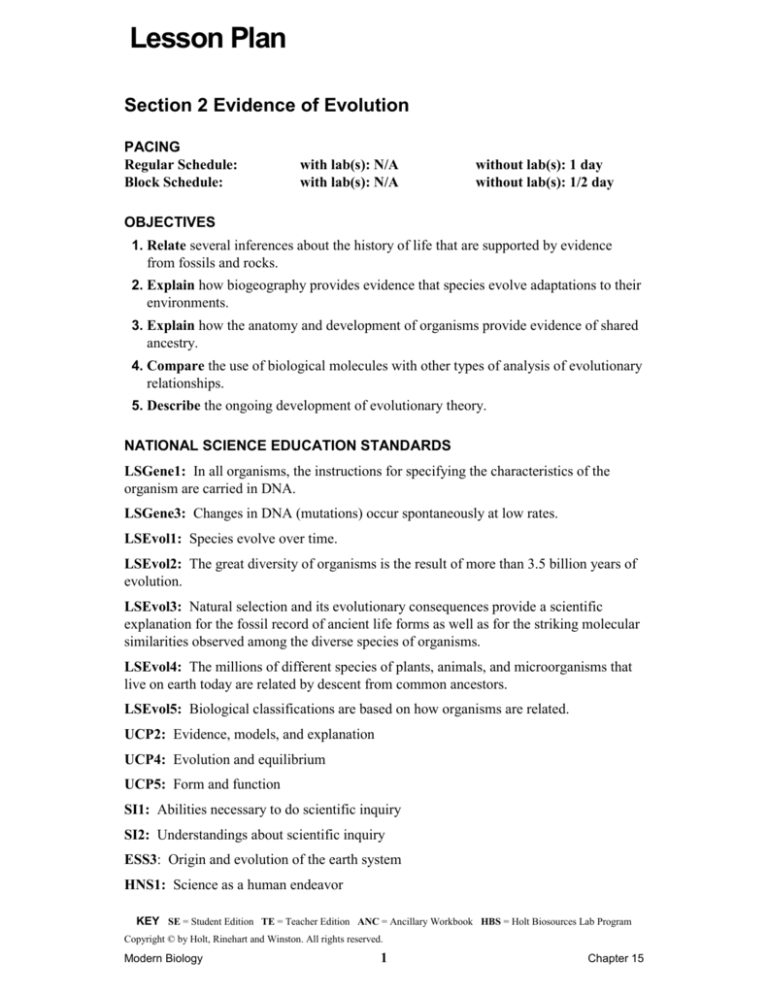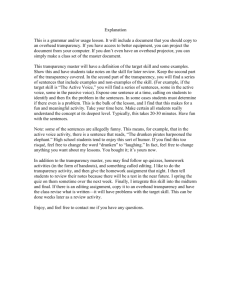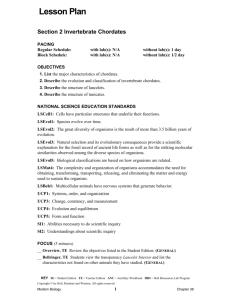
Lesson Plan
Section 2 Evidence of Evolution
PACING
Regular Schedule:
Block Schedule:
with lab(s): N/A
with lab(s): N/A
without lab(s): 1 day
without lab(s): 1/2 day
OBJECTIVES
1. Relate several inferences about the history of life that are supported by evidence
from fossils and rocks.
2. Explain how biogeography provides evidence that species evolve adaptations to their
environments.
3. Explain how the anatomy and development of organisms provide evidence of shared
ancestry.
4. Compare the use of biological molecules with other types of analysis of evolutionary
relationships.
5. Describe the ongoing development of evolutionary theory.
NATIONAL SCIENCE EDUCATION STANDARDS
LSGene1: In all organisms, the instructions for specifying the characteristics of the
organism are carried in DNA.
LSGene3: Changes in DNA (mutations) occur spontaneously at low rates.
LSEvol1: Species evolve over time.
LSEvol2: The great diversity of organisms is the result of more than 3.5 billion years of
evolution.
LSEvol3: Natural selection and its evolutionary consequences provide a scientific
explanation for the fossil record of ancient life forms as well as for the striking molecular
similarities observed among the diverse species of organisms.
LSEvol4: The millions of different species of plants, animals, and microorganisms that
live on earth today are related by descent from common ancestors.
LSEvol5: Biological classifications are based on how organisms are related.
UCP2: Evidence, models, and explanation
UCP4: Evolution and equilibrium
UCP5: Form and function
SI1: Abilities necessary to do scientific inquiry
SI2: Understandings about scientific inquiry
ESS3: Origin and evolution of the earth system
HNS1: Science as a human endeavor
KEY SE = Student Edition TE = Teacher Edition ANC = Ancillary Workbook HBS = Holt Biosources Lab Program
Copyright © by Holt, Rinehart and Winston. All rights reserved.
Modern Biology
1
Chapter 15
Lesson Plan
HNS2: Nature of scientific knowledge
FOCUS (5 minutes)
__ Overview, TE Review the objectives listed in the Student Edition. (GENERAL)
__ Bellringer, TE Ask students to brainstorm how living organisms provide evidence for
evolution. (GENERAL)
MOTIVATE (5 minutes)
__ Demonstration, Earth’s History of Life, TE Use the Geologic Time Scale in the
Appendix to show students Earth’s history of life. (BASIC)
TEACH (25 minutes)
__ PowerPoint® Resources Use the customizable presentation to help students master the
concepts in this section.
__ Teaching Transparency D12, Distribution of Fossils Use this transparency to explore
the distribution of fossils with students. (GENERAL)
__ Reading Skill Builder, Exploring Primary Sources, TE Students research and write a
report about one of the major mass extinction events. (ADVANCED)
__ Teaching Tip, Not Always Simple to Complex, TE Discuss how evolution does not
have directionality and does not always result in more complex organisms. (GENERAL)
__ Internet Activity, Extinction, TE Have students research the process of extinction by
using the Internet Connect box on this page. (GENERAL)
__ Group Activity, Making “Fossils’” TE Students use petroleum jelly and plaster of Paris
to make molds and casts of leaves, shells, or bones. (GENERAL)
__ Skill Builder, Interpreting Diagrams, TE Students select a structure in the illustration
of whale evolution and describe how the structure changed over time. (GENERAL)
__ Teaching Transparency D13, Evidence of Whale Evolution Use this transparency to
review the evidence of whale evolution. (GENERAL)
__ Teaching Tip, Evidence for Evolution, TE Students make a graphic organizer that
describes three kinds of traits used to support evolution by natural selection. (BASIC)
__ Discussion, Ancestor Versus Relative, TE Students discuss the difference between an
ancestor and a relative. (GENERAL)
__ Teaching Tip, “Ontology Recapitulates Phylogeny,” TE Discuss with students this
phrase used by Ernst Haeckle and what it means. (GENERAL)
__ Teaching Transparency D14, Forelimbs of Vertebrates Use this transparency to
review the forelimbs of vertebrates with students. (GENERAL)
__ Using the Figure, Embryonic Development, TE Ask students what characteristics the
earliest stages of the embryos share. (GENERAL)
__ Teaching Tip, Cytochrome c Similarities, TE Ask students to explain the lack of
difference between human’s and chimpanzee’s cytochrome c. (GENERAL)
KEY SE = Student Edition TE = Teacher Edition ANC = Ancillary Workbook HBS = Holt Biosources Lab Program
Copyright © by Holt, Rinehart and Winston. All rights reserved.
Modern Biology
2
Chapter 15
Lesson Plan
__ Teaching Transparency D15, Comparing Vertebrate Embryo Development Use this
transparency to compare vertebrate embryo development. (GENERAL)
__ Teaching Transparency D16, Hemoglobin Comparison Use this transparency to
illustrate the hemoglobin comparison shown. (GENERAL)
__ Using the Figure, Evolutionary Trees, TE Ask how scientists inferred the relationships
between these organisms in order to formulate this kind of diagram. (GENERAL)
__ Teaching Transparency D17, Evolutionary Relationship Between Whales and
Hoofed Mammals Use this transparency to discuss the hypothesis of the relationships
among whales and hoofed mammals. (GENERAL)
CLOSE (10 minutes)
__ Section Review, SE Students are assessed through questions about key concepts and
questions that require critical thinking skills. (GENERAL)
__ Reteaching, Phylogenetic Relationships, TE Provide students with pictures of two
winged animals. Ask students how a scientist might classify these animals incorrectly if
the wings were assumed to be homologous structures. (BASIC)
__ Quiz, TE Students answer short answer questions about this section. (GENERAL)
OTHER RESOURCE OPTIONS
__ Active Reading Worksheets, ANC Students are asked to analyze a passage related to the
chapter text and answer questions about the passage. (BASIC)
__ Quick, Data, and Math Labs, Comparing Limb Structure and Function, HBS
Students compare the limbs of eight different animals, identify relationships between the
structures, and look for evidence that these animals are related to one another. (GENERAL)
__ Visual Concepts CD-ROM Use this multimedia resource to reinforce selected concepts
from the chapter.
KEY SE = Student Edition TE = Teacher Edition ANC = Ancillary Workbook HBS = Holt Biosources Lab Program
Copyright © by Holt, Rinehart and Winston. All rights reserved.
Modern Biology
3
Chapter 15












